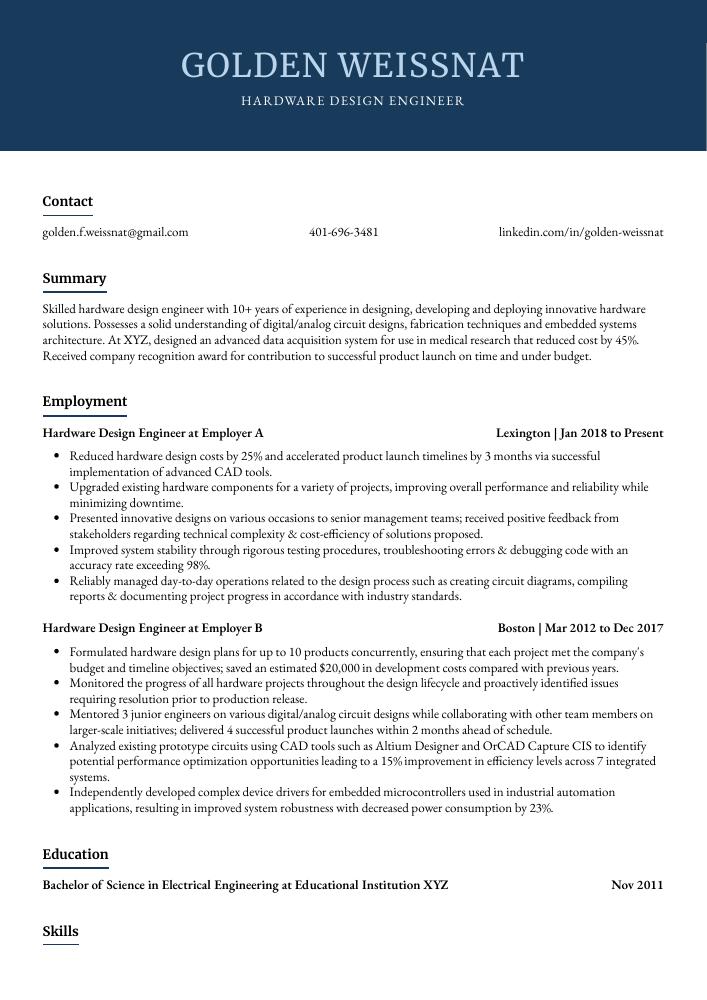Hardware Design Engineer Resume Guide
Hardware design engineers develop and create electronic systems used in a variety of applications. They are responsible for designing, testing, and implementing new hardware components as well as troubleshooting existing ones. Additionally, they work with other teams to ensure that their designs meet the requirements of the project’s specifications.
You have the knowledge and experience to design any hardware system with ease. But potential employers don’t know that yet, so you need a resume that highlights your qualifications in order to get their attention.
This guide will walk you through the entire process of creating a top-notch resume. We first show you a complete example and then break down what each resume section should look like.
Table of Contents
The guide is divided into sections for your convenience. You can read it from beginning to end or use the table of contents below to jump to a specific part.
Hardware Design Engineer Resume Sample
Golden Weissnat
Hardware Design Engineer
[email protected]
401-696-3481
linkedin.com/in/golden-weissnat
Summary
Skilled hardware design engineer with 10+ years of experience in designing, developing and deploying innovative hardware solutions. Possesses a solid understanding of digital/analog circuit designs, fabrication techniques and embedded systems architecture. At XYZ, designed an advanced data acquisition system for use in medical research that reduced cost by 45%. Received company recognition award for contribution to successful product launch on time and under budget.
Experience
Hardware Design Engineer, Employer A
Lexington, Jan 2018 – Present
- Reduced hardware design costs by 25% and accelerated product launch timelines by 3 months via successful implementation of advanced CAD tools.
- Upgraded existing hardware components for a variety of projects, improving overall performance and reliability while minimizing downtime.
- Presented innovative designs on various occasions to senior management teams; received positive feedback from stakeholders regarding technical complexity & cost-efficiency of solutions proposed.
- Improved system stability through rigorous testing procedures, troubleshooting errors & debugging code with an accuracy rate exceeding 98%.
- Reliably managed day-to-day operations related to the design process such as creating circuit diagrams, compiling reports & documenting project progress in accordance with industry standards.
Hardware Design Engineer, Employer B
Boston, Mar 2012 – Dec 2017
- Formulated hardware design plans for up to 10 products concurrently, ensuring that each project met the company’s budget and timeline objectives; saved an estimated $20,000 in development costs compared with previous years.
- Monitored the progress of all hardware projects throughout the design lifecycle and proactively identified issues requiring resolution prior to production release.
- Mentored 3 junior engineers on various digital/analog circuit designs while collaborating with other team members on larger-scale initiatives; delivered 4 successful product launches within 2 months ahead of schedule.
- Analyzed existing prototype circuits using CAD tools such as Altium Designer and OrCAD Capture CIS to identify potential performance optimization opportunities leading to a 15% improvement in efficiency levels across 7 integrated systems.
- Independently developed complex device drivers for embedded microcontrollers used in industrial automation applications, resulting in improved system robustness with decreased power consumption by 23%.
Skills
- Embedded Systems
- Electronics
- MATLAB
- PCB Design
- C
- Hardware Architecture
- Testing
- C++
- Verilog
Education
Bachelor of Science in Electrical Engineering
Educational Institution XYZ
Nov 2011
Certifications
CompTIA A+
CompTIA (Computing Technology Industry
May 2017
1. Summary / Objective
Your resume summary/objective should provide the hiring manager with a snapshot of your experience and skills as a hardware design engineer. This is where you can highlight your knowledge in circuit board design, embedded systems programming, and microcontroller architecture. You could also mention any recent certifications or awards you have received for excellence in engineering projects.
Below are some resume summary examples:
Well-rounded hardware design engineer with 7+ years of experience in designing, developing and testing complex electronic products. Proven track record of increasing product performance by up to 10% through meticulous circuit board layout optimization and cost-reduction initiatives. At XYZ Corp., designed a power supply system that reduced energy consumption by 20%. Experienced in working with microcontrollers such as ARM Cortex M3/M4 MCU’s & PIC16F series devices.
Detail-oriented hardware design engineer with 5+ years of experience in designing and developing embedded systems for consumer electronics. At ABC, created a high-end consumer audio product that increased sales by 25%. Developed innovative solutions for hardware requirements in the areas of power management, signal integrity, and RF communications. Expertise includes FPGA designs using VHDL/Verilog as well as board layout optimization to reduce EMI noise.
Talented hardware design engineer with 5+ years of experience in the development, prototyping and testing of embedded systems. Experienced in all stages of hardware design from concept to production-ready products. Skilled at working with a variety of microcontrollers, FPGAs, HDLs and PCB layout tools for complex designs. Proven track record for developing reliable low power solutions that meet customer requirements on time and within budget constraints.
Proficient hardware design engineer with 7+ years of experience in designing, building, and testing embedded systems. Expertise in developing hardware solutions for industrial automation projects and working on various platforms like ARM and PIC microcontrollers. At XYZ Company, successfully completed a project to develop an advanced motor controller system from scratch within tight deadlines. Highly organized with exceptional problem-solving skills.
Driven hardware design engineer with 6+ years of experience in designing, testing, and debugging complex hardware systems. Proven track record of successfully leading small teams to develop innovative products that meet customer requirements while improving performance metrics. Seeking to join ABC Tech as a senior engineer where I can apply my expertise in FPGA/ASIC/VLSI engineering and bring new ideas for projects and product designs.
Energetic and experienced hardware design engineer with 8+ years of experience in designing and developing electronic circuitry for a variety of applications. Seeking to join ABC Tech to use my knowledge and skillset in creating high-quality, cost-effective designs that meet customer requirements. In previous roles, reduced product development time by 20% while maintaining quality standards.
Passionate hardware design engineer with 5+ years of experience designing and building embedded systems for applications ranging from medical devices to consumer electronics. Proficient in C, Python, and microcontroller programming languages. Seeking the opportunity to join ABC Tech to develop high-quality hardware solutions that meet customer needs while pushing technology boundaries.
Amicable and detail-oriented hardware design engineer with 8+ years of experience in circuit board, component selection and system integration. Proven track record for developing robust designs that meet customer requirements while optimizing cost and performance. Seeking to join ABC Company as a Hardware Design Engineer to leverage my expertise in creating cutting-edge products.
2. Experience / Employment
In the experience section of your resume, you should list all relevant employment history in reverse chronological order. This means that the most recent job is listed first and then each previous role follows it.
When writing out what you did on a daily basis, use bullet points to make it easier for the reader to digest this information quickly. You want to think about providing detail here and include any quantifiable results achieved from your work. For example, instead of saying “Designed hardware,” you could say, “Created 3D models of complex electronic components using SolidWorks software; reduced design time by 25% compared with traditional methods.”
To write effective bullet points, begin with a strong verb or adverb. Industry specific verbs to use are:
- Designed
- Fabricated
- Programmed
- Assembled
- Tested
- Debugged
- Analyzed
- Optimized
- Documented
- Troubleshot
- Implemented
- Calibrated
- Configured
- Monitored
- Upgraded
Other general verbs you can use are:
- Achieved
- Advised
- Assessed
- Compiled
- Coordinated
- Demonstrated
- Developed
- Expedited
- Facilitated
- Formulated
- Improved
- Introduced
- Mentored
- Participated
- Prepared
- Presented
- Reduced
- Reorganized
- Represented
- Revised
- Spearheaded
- Streamlined
- Structured
- Utilized
Below are some example bullet points:
- Structured and optimized hardware design process to increase efficiency by 25%, resulting in a 15% reduction in overall project cost.
- Reorganized and standardized components inventory, reducing wasted time spent on locating parts by 50%.
- Spearheaded the development of new electronic device prototypes from concept to production-ready state within budget and before deadline, improving customer satisfaction by 30%.
- Developed innovative solutions for complex product designs that incorporated feedback from stakeholders; increased output quality tenfold with 20% fewer resources used compared to industry standard processes.
- Consistently updated systems software specifications and debugging procedures for improved accuracy in performance testing, achieving 99% defect free products across all major releases over the past year.
- Programmed embedded microcontrollers for 3 hardware designs, resulting in a 40% reduction of total development time.
- Debugged and modified circuit boards used for product testing; improved the accuracy of results by 30%.
- Thoroughly studied schematics to assess the compatibility and performance of electronic components with existing systems prior to production launch.
- Assessed customer needs when developing new products, identified areas where improvements could be made and reduced design flaws by 15%.
- Coordinated with various departments such as manufacturing and sales during product roll-outs; successfully completed 5 projects on schedule within budget constraints while ensuring quality standards were met at all times.
- Confidently designed, developed and tested hardware systems and components for more than 10 high-complexity projects, decreasing overall production time by 30%.
- Compiled extensive reports to track progress of design projects; provided detailed specs on functionality and performance of each device.
- Expedited the validation process through comprehensive testing, ensuring all new designs met industry standards before launch date.
- Advised upper management on optimal cost-effective solutions that improved delivery times while maintaining quality assurance protocols; saved $8,000 in overhead costs over 6 months period.
- Designed prototypes with CAD tools to demonstrate potential novel applications of existing technologies; enhanced customer experience by 20% within 2 weeks after implementation.
- Prepared detailed designs and schematics for a variety of hardware devices, such as computers, phones, radios and medical equipment; reduced development time by 15%.
- Achieved 50% cost savings on component parts through the effective selection of quality vendors; improved project profitability by $20K in one year.
- Accurately documented all changes to design specifications throughout the engineering process and maintained up-to-date records that led to successful product launches ahead of schedule.
- Facilitated communication between team members across multiple departments ensuring smooth execution of projects within budgeted timelines while meeting customer requirements & expectations at all times.
- Utilized software packages including AutoCAD, SolidWorks & Pro/Engineer Wildfire to develop 3D models and test prototypes prior to production release; attained an average error rate reduction rate of 18%.
- Fabricated over 200 hardware components for various electronic systems, including PCBs, power supplies and signal processing circuitry; saved $5K in production costs by utilizing recycled materials.
- Assembled electrical circuits and tested them for performance accuracy according to industry standards; improved average assembly time by 30%.
- Documented all stages of design process from concept inception through testing phases using CAD software such as Altium Designer & KiCAD; achieved a 25% increase in design efficiency over the course of 6 months.
- Streamlined manufacturing process with automation tools that reduced prototyping cost by 40%, while ensuring consistent quality output on every product line within budget constraints.
- Substantially increased customer satisfaction levels after introducing two new products into the market within one year, resulting in 20% growth in sales revenue over 6 months period.
- Actively designed, tested and implemented hardware solutions for over 50+ projects from conception to completion; successfully delivered all projects on or ahead of schedule.
- Demonstrated proficiency in developing system architectures and board designs utilizing the latest industry standards, resulting in a reduction of system costs by 15%.
- Represented company at trade shows & conferences to promote products and develop relationships with potential partners; generated an additional $25K in new sales leads each year.
- Introduced innovative design strategies that optimized PCB layout topologies while meeting customer requirements; improved signal integrity by 20% within 6 months of implementation.
- Revised existing systems while maintaining compatibility with current hardware configurations; ensured overall performance was increased 5-fold during testing stages without any downtime/interruptions.
- Participated in the design and development of 10+ hardware systems, integrating various components including microprocessors, memories, power supplies and other electrical circuits.
- Meticulously designed 200+ schematics using CAD software to ensure that all circuit boards met product requirements; reduced overall defect rate by 8%.
- Optimized existing system designs through analysis of performance data gathered from simulations and laboratory tests; achieved a 25% increase in speed & efficiency on average with each upgrade cycle.
- Tested new products across multiple platforms for compatibility issues while maintaining product specifications within budget constraints; completed projects 6 weeks ahead of schedule on 3 occasions last year alone.
- Troubleshot problems encountered during production stages to quickly resolve any potential defects or malfunctions before reaching customers; minimized customer complaints by 50% over 12 months period due to effective problem solving techniques used.
- Calibrated and tested complex circuitry, analog and digital systems to ensure that hardware components were in line with design specifications; improved accuracy by 17%.
- Configured a wide range of hardware tools and devices for multiple projects, including single-board computers, routers & switches, ensuring compatibility across all platforms.
- Implemented new designs into existing products using C++ language programming to improve customer experience; reduced customer complaints by 22%.
- Successfully developed 5+ prototypes from initial concept through final testing phase within tight deadlines; increased productivity levels on average by 10 hours per project cycle.
3. Skills
Skill requirements will differ from employer to employer – this can easily be determined via the job advert. Organization ABC may be looking for a hardware design engineer with experience in developing embedded systems, while Organization XYZ may require someone experienced in designing circuit boards.
To ensure that your resume is seen by the right people, you should tailor the skills section of your resume to each job that you are applying for. This will help applicant tracking systems (computer programs used by many employers) accurately identify whether or not you have the required qualifications and technical knowledge they are seeking.
In addition to listing relevant skills here, it’s also important to discuss them in more detail elsewhere on your resume – such as within the summary statement or work history sections.
Below is a list of common skills & terms:
- ASIC
- Altium Designer
- Analog
- Analog Circuit Design
- Application Specific Integrated Circuits
- AutoCAD
- C
- C++
- Cadence
- Cadence Virtuoso
- Circuit Design
- Computer Architecture
- Computer Hardware
- Debugging
- Design for Manufacturing
- Digital Signal Processors
- Electrical Engineering
- Electronics
- Embedded Software
- Embedded Systems
- Engineering
- Engineering Management
- Ethernet
- FPGA
- Field Programmable Gate Arrays
- Firmware
- Hardware
- Hardware Architecture
- IC
- Java
- LTspice
- LabVIEW
- Linux
- MATLAB
- Manufacturing
- Microcontrollers
- Microprocessors
- ModelSim
- PCB Design
- PCIe
- PSpice
- Perl
- Product Development
- Programming
- Python
- RF
- RTL Design
- SOC
- SOLIDWORKS
- Schematic Capture
- Semiconductors
- Sensors
- Signal Integrity
- Simulations
- Simulink
- Systems Engineering
- TCL
- Teamwork
- Telecommunications
- Testing
- Troubleshooting
- VHDL
- VLSI
- Verilog
- Windows
- Wireless
- Xilinx
4. Education
Including an education section on your resume will depend largely on how far along you are in your career. If you just graduated and have no work experience, including an education section is a must as it gives employers insight into the knowledge base that led to you becoming a hardware design engineer. However, if you already have significant work experience with multiple companies under your belt, omitting the education section completely is perfectly fine.
If included, try to mention courses and subjects related to the hardware design engineering role for which you are applying.
Bachelor of Science in Electrical Engineering
Educational Institution XYZ
Nov 2011
5. Certifications
Certifications are a great way to demonstrate your expertise in a particular field. They show potential employers that you have taken the time and effort to become certified in an area of specialization, which can give you an edge over other applicants.
When applying for jobs, include any certifications relevant to the position on your resume as this will help showcase your qualifications and increase your chances of getting hired.
CompTIA A+
CompTIA (Computing Technology Industry
May 2017
6. Contact Info
Your name should be the first thing a reader sees when viewing your resume, so ensure its positioning is prominent. Your phone number should be written in the most commonly used format in your country/city/state, and your email address should be professional.
You can also choose to include a link to your LinkedIn profile, personal website, or other online platforms relevant to your industry.
Finally, name your resume file appropriately to help hiring managers; for Golden Weissnat, this would be Golden-Weissnat-resume.pdf or Golden-Weissnat-resume.docx.
7. Cover Letter
Including a cover letter with your resume when applying for a job is an important step in the hiring process. Cover letters are short documents that provide additional information about you, such as why you’re interested in the role and what makes you a strong candidate.
Writing cover letters can be intimidating but it’s worth taking the time to craft one if possible. It gives recruiters more insight into who you are and allows them to get to know your personality before they even meet with you!
Below is an example cover letter:
Dear Sabrina,
I am writing to apply for the Hardware Design Engineer position at [company name]. As a hardware engineer with 6+ years of experience designing, testing, and troubleshooting electronic devices, I am confident I will be an asset to your organization.
In my previous role as a hardware design engineer at [company name], I was responsible for the design and development of high-speed digital circuits for use in telecommunications applications. My experience includes working with a team of engineers to create circuit designs that meet customer specifications, developing simulation models to test circuit performance, and debugging issues during the manufacturing process. In addition, I have experience preparing technical reports and presentations to communicate results to colleagues and clients.
I believe my skills and experience make me an ideal candidate for this position. I am excited about the opportunity to work on challenging projects and contribute to the success of your organization. Thank you for your time and consideration; I look forward to hearing from you soon.
Sincerely,
Golden
Hardware Design Engineer Resume Templates
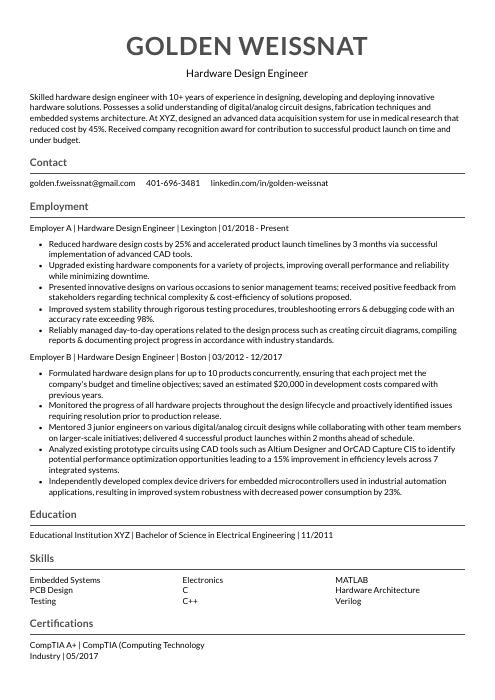 Indri
Indri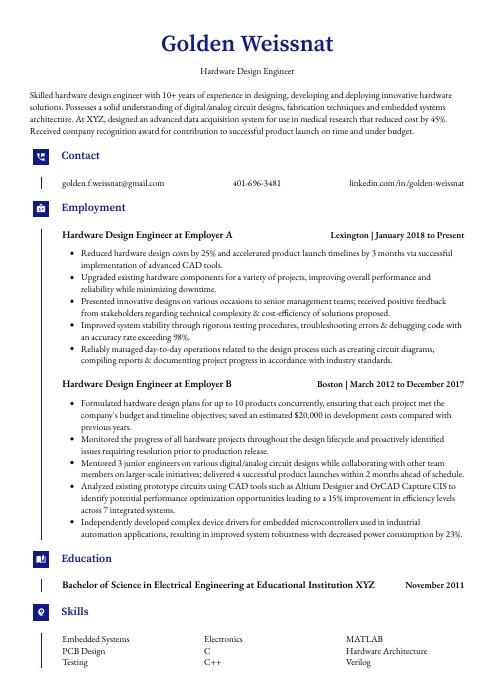 Gharial
Gharial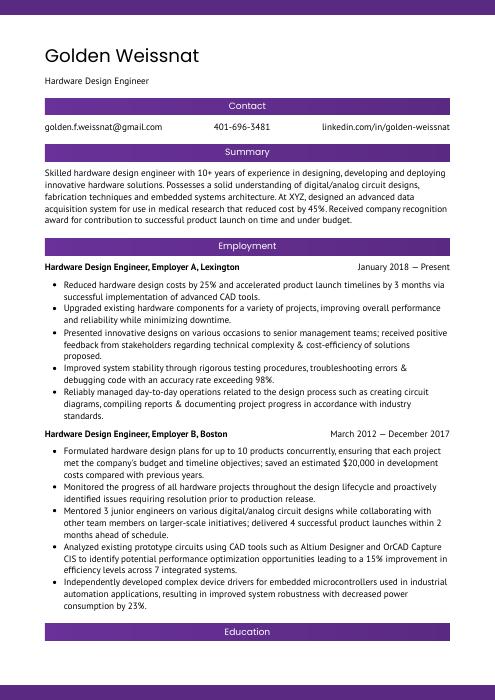 Jerboa
Jerboa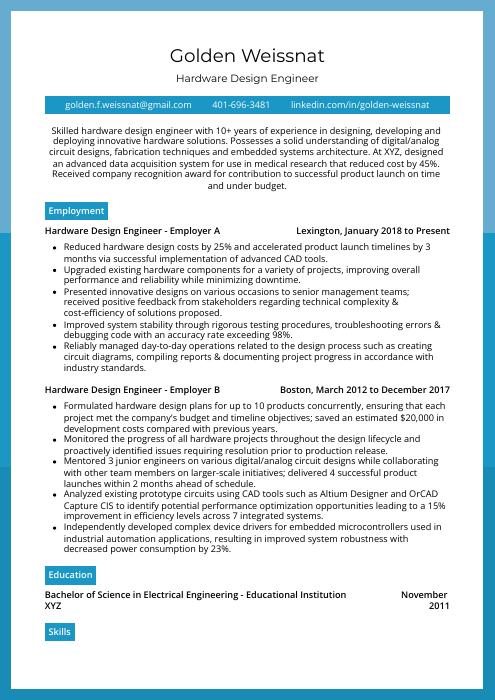 Rhea
Rhea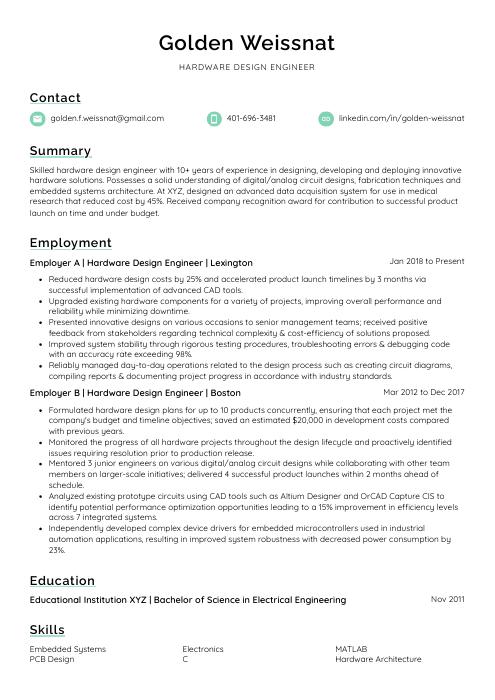 Lorikeet
Lorikeet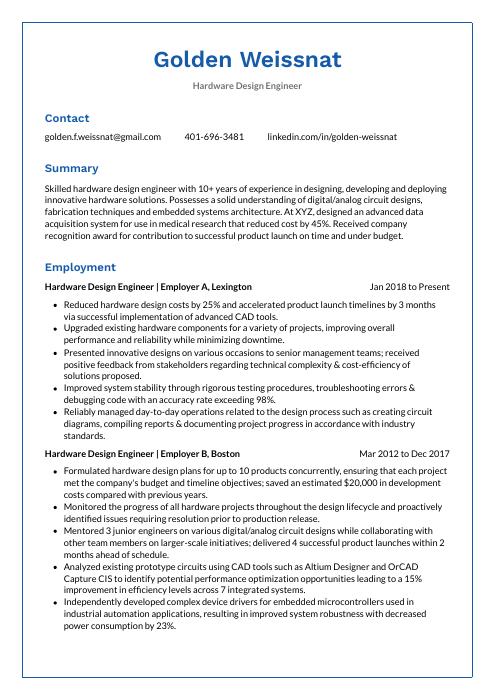 Markhor
Markhor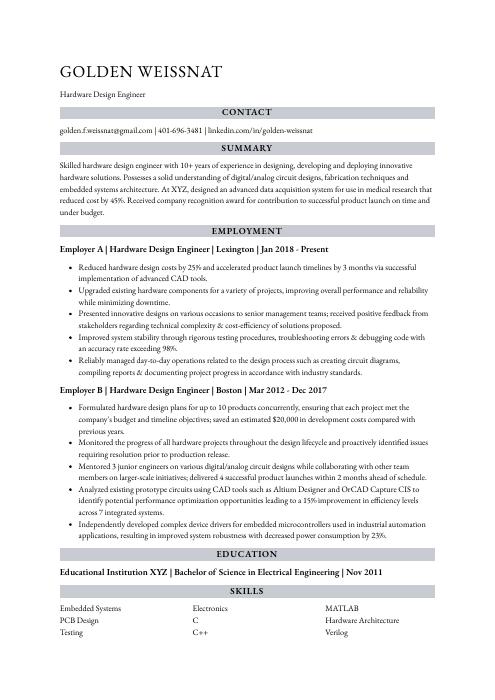 Numbat
Numbat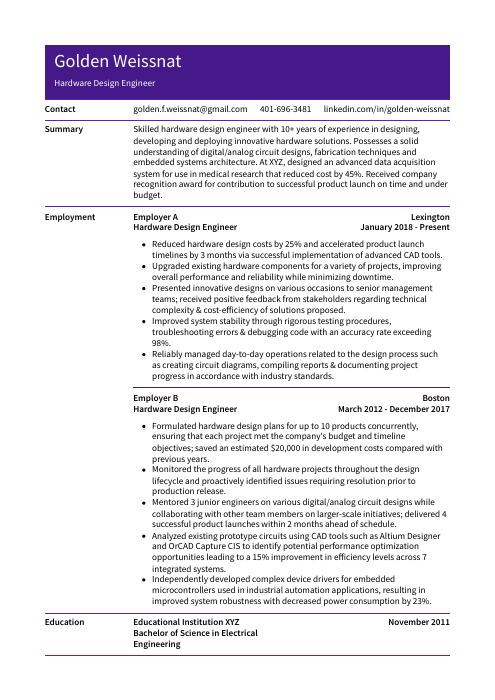 Pika
Pika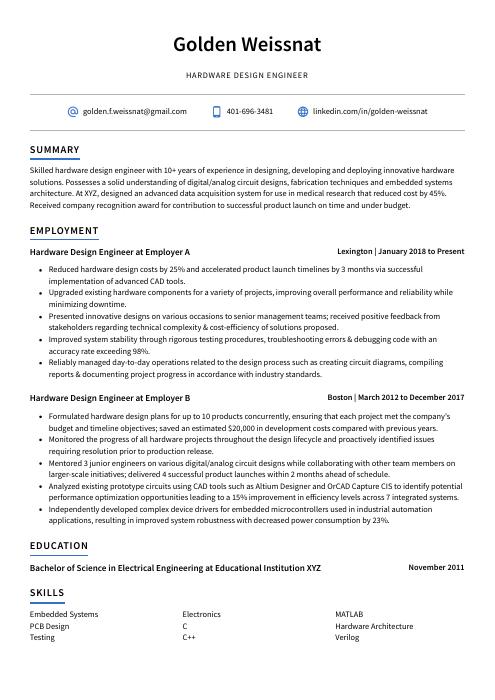 Axolotl
Axolotl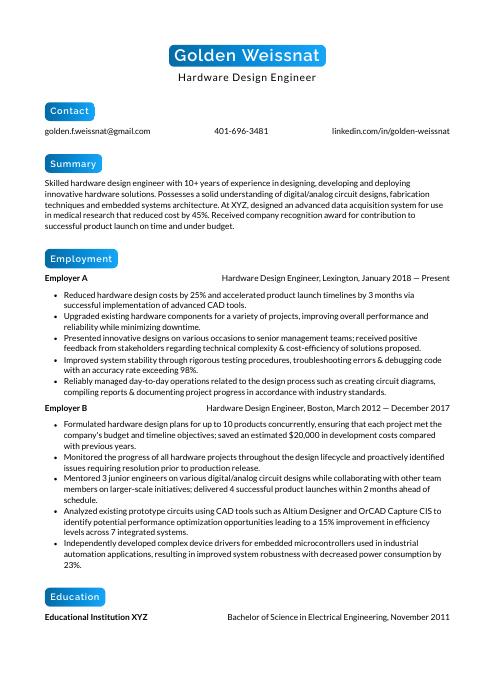 Kinkajou
Kinkajou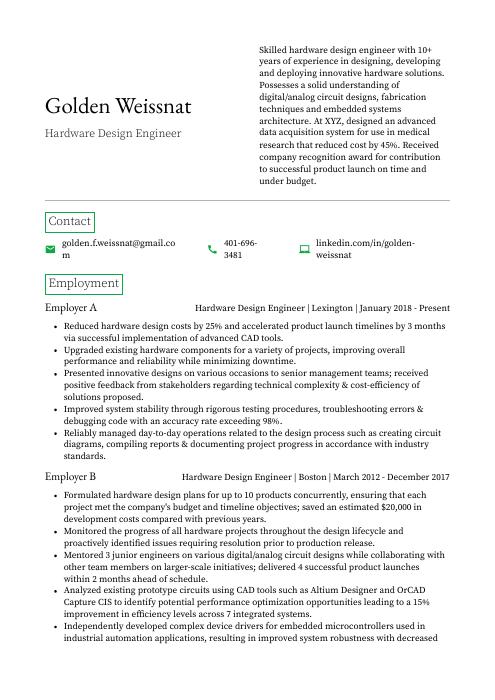 Quokka
Quokka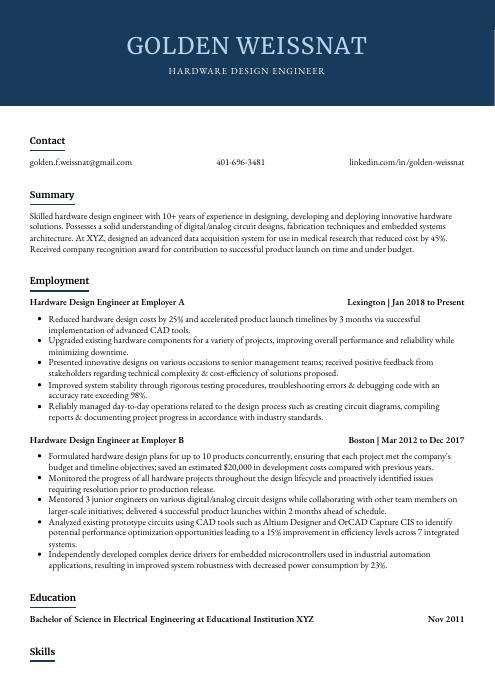 Bonobo
Bonobo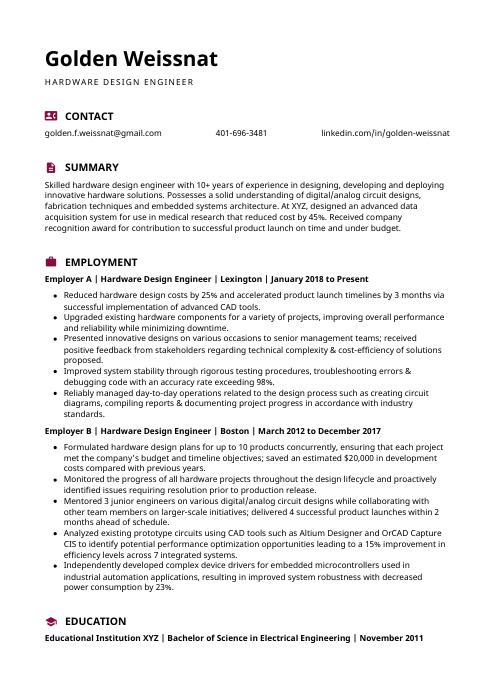 Hoopoe
Hoopoe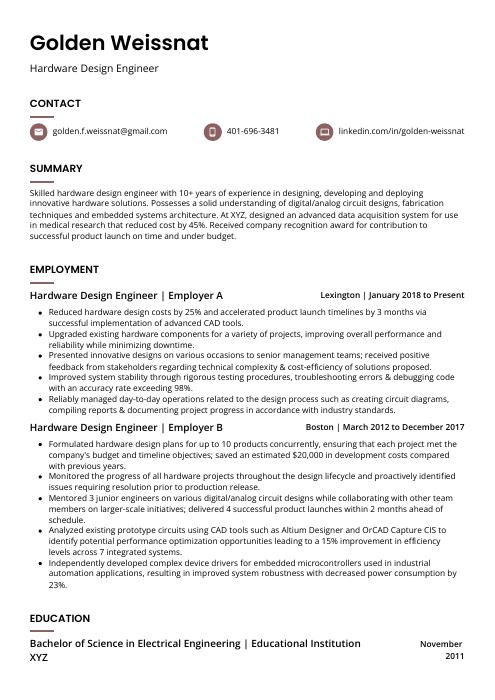 Fossa
Fossa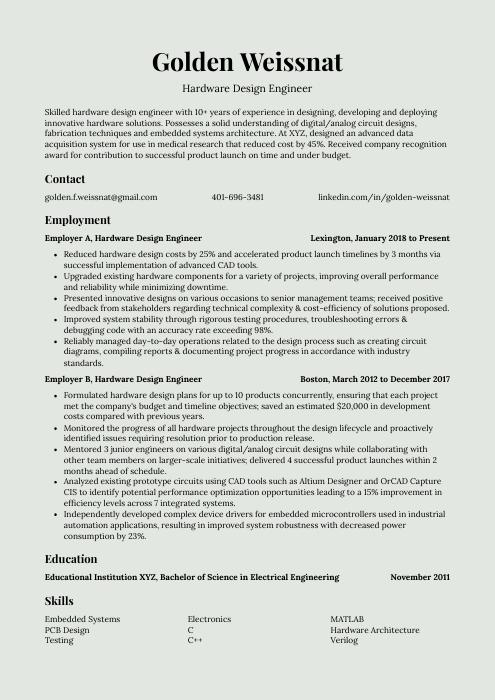 Saola
Saola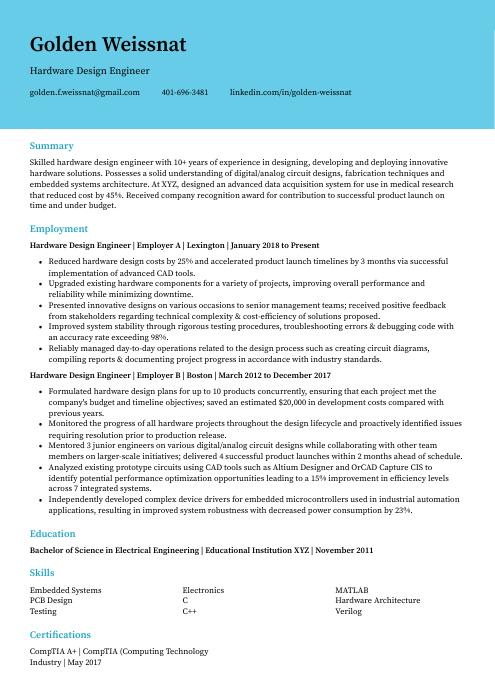 Dugong
Dugong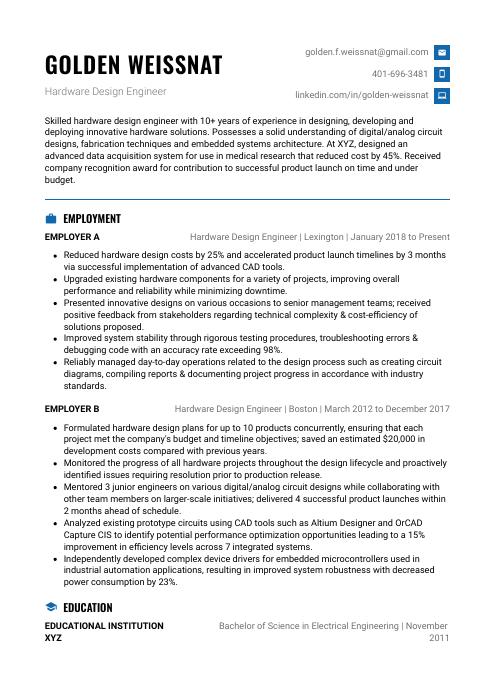 Echidna
Echidna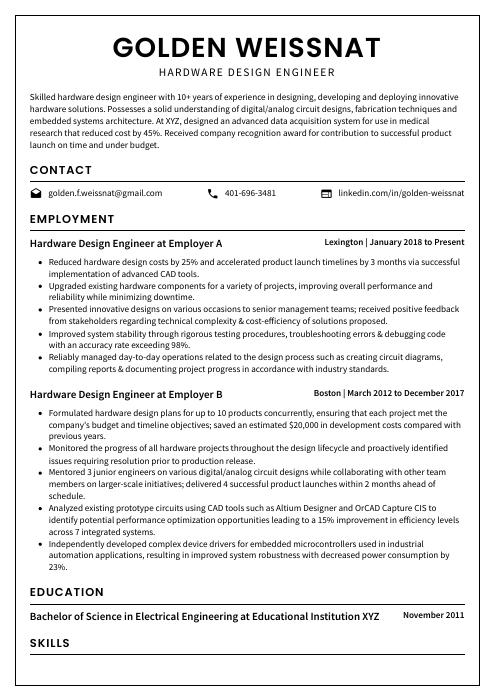 Cormorant
Cormorant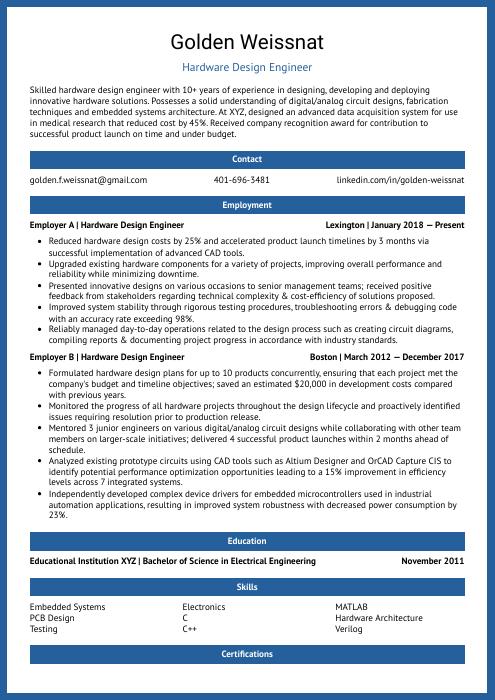 Ocelot
Ocelot Rezjumei
Rezjumei
